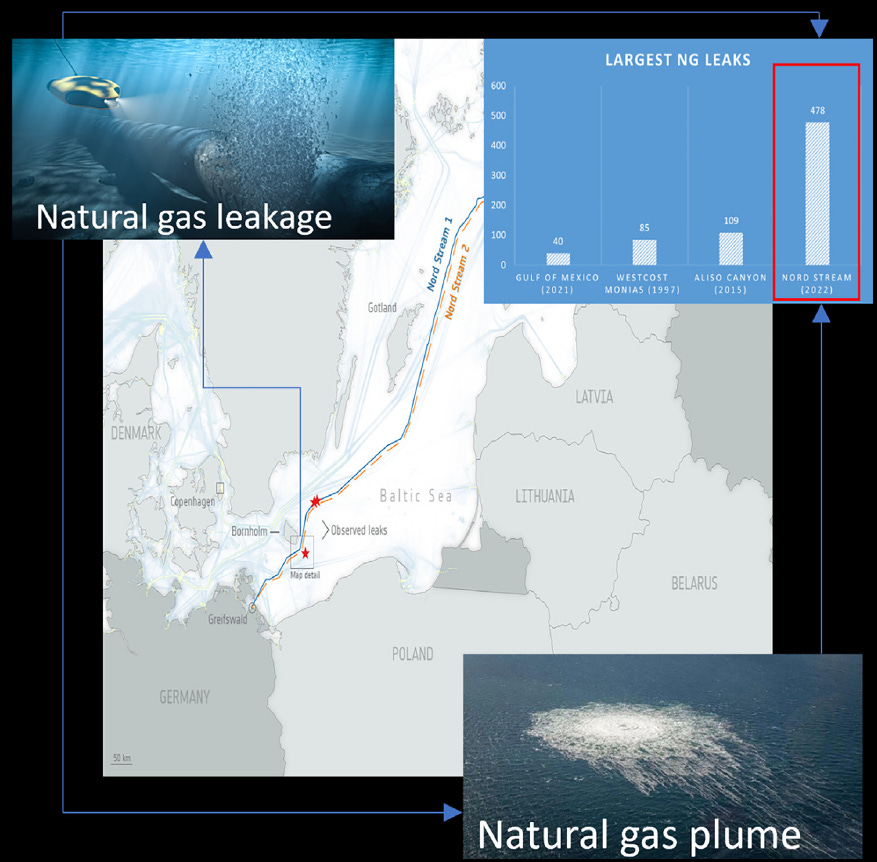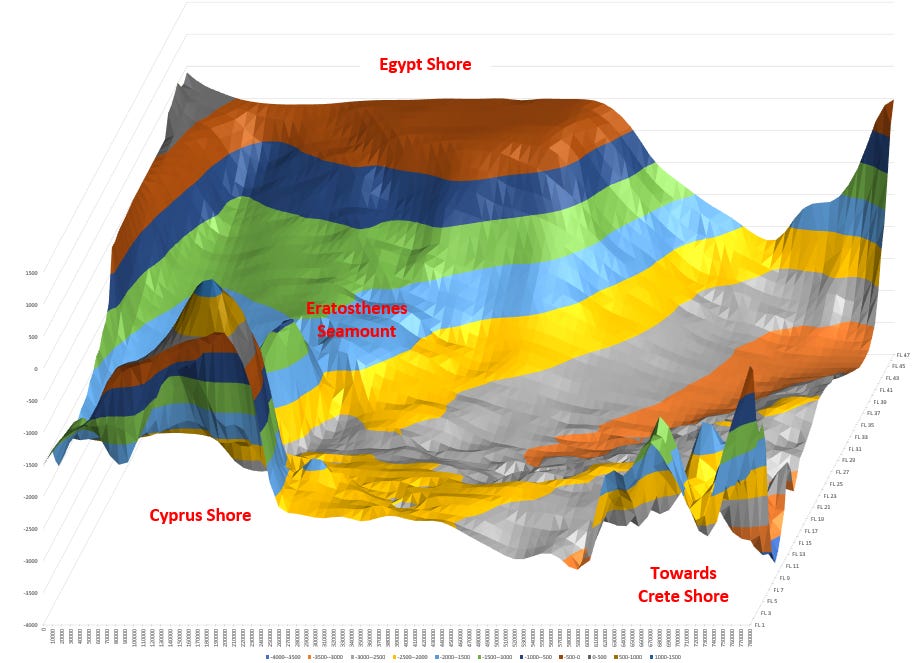Energy Highways: Politics Beneath the Waves
"Who blew up Nord Stream?" - Tucker Carlson
Before we even set out to explore the Nord Stream explosion in our upcoming Substack, a curious twist emerged…. Tucker Carlson seemingly had a foresight, almost as if he knew our story was in the making, creating an excellent clickbait for us (ha!).
Of course we won't comment on Putin's response, and on any of other Leader’s responses, it’s not our job… We just have to acknowledge that responding to these kind of questions it’s not an easy task. While this might be intriguing clickbait, our focus today is not on politics but on the fascinating engineering behind the scenes. Politics has never been my forte, and it might never be. So rest assured that the core of this article delves into the captivating world of engineering intricacies often overshadowed by political theatrics.
Back in 2022, while I was preparing my bags for my vacation back to Cyprus, I received a call from my former Professor Dr. Hadjistassou, asking:
“Hey Kostas, how is everything? Have you heard about the Nord Stream incident? I think we should estimate the amount of the methane leak... Can we do that?”
I remember my words as it was yesterday:
“There is nothing we can’t do. Give me an office at the Uni tomorrow, and tell the security to not kick me off at night.”
My schedule was pretty tight, and I had only 1 weekend to see how we can approach it, build the main model, and then arrange the timelines for the article preparation. It didn’t take long, so the next day we had a meeting with the Professor to gather the assumptions and discuss the methodology. After a couple of hours we ended-up with 2 “beautiful” whiteboards, one from which is presented below (the other one is secret, as well as the erased versions that I ended up writing the same night).
To give you a little bit of a context, Nord Stream (NS) consists of four offshore export lines which cross the Baltic Sea and, until recently, used to source Russian natural gas to Germany. At a capacity of 110 billion cubic meters per year, the NS1 and NS2 pipeline system exhibiting an internal diameter of 1,153 mm and stretching some 1,224 km is the largest in the world.
A notice issued by the Geological Survey of Denmark, on the 26th of September, 2022, which alluded to three submarine explosions that occurred at three distinct locations helped pinpoint the time and location of the three NS1 and NS2 leaks. More specifically, the first blast tied to NS2 was registered at 02:03a.m. (CEST) while the second and third events, linked to NS1, were recorded at 07:03p.m. Subsequently, the Danish Airforce identified the geographical location of the NS2 leak, which affected line A, as being southeast of the Bornholm Island. Shortly after the last two blasts, the Swedish authorities traced two sea-surface gas plumes in lines A and B, of the NS1 pipeline system, transcending the Danish-Swedish Exclusive Economic Zones (EEZs). Video footage from the NS1 pipeline has revealed widespread destruction to the ruptured pipeline with a missing section deemed to stretch about 50 m. Have a look on the attached video below “Underwater footage shows damage to Nord Stream pipeline” (Ref. The Independent TV, Youtube).
It was not easy to develop a representative model…. Unfortunately, each software has it’s limitations. However, as I said to my professor, nothing is impossible. Despite the difficulties, we developed an advanced multi-phase quasi-numerical pipeline in situ model with the primary aim of accurately determining the volume of natural gas released from the three ruptured pipelines during the Nord Stream incident. Our analysis revealed that a substantial 478,000 tonnes of methane had been released into the atmosphere, marking this event as the largest of its kind globally (see figure below).

Employing cutting-edge computational techniques, particularly utilizing OLGA, we simulated intricate scenarios to precisely estimate the extent of the gas leak. The model not only provides insights into the Nord Stream incident's magnitude and characteristics but also has the potential to validate estimates from other methods, such as remote sensing. For that, we’ve run a parametric analysis which showed the amount of methane that could have been leaked, if the Nord Stream pipeline was at different in-situ pressures (see below). This figure was excluded from the paper due to the word limitations…. (So, keep reading our Substack for beyond-the-scenes [BTS] content!)
After months of dedicated efforts from Dr. Hadjistassou and Ms. Sharanik, the paper detailing this study has been successfully published in iScience. I must acknowledge that without the collective collaboration of everyone involved, this article wouldn't have come to fruition. Kudos to the entire team! For those interested in delving into the complete article, the link is provided below:
"World’s largest natural gas leak from nord stream pipeline estimated at 478,000 tonnes" (Me, Jumana Sharanik, Constantinos Hadjistassou)

In case you don’t have the time to go through the full paper, we summarized the key findings and recommendations below:
Key Findings
Nord Stream gas leaks released about 478,000 tonnes of methane into the environment.
The incident constitutes the largest single methane gas source in recent memory.
The amount of gas and duration of the episode align with other estimates.
Key Recommendations
Immediate action to address methane emissions from pipelines globally.
Continued research and investment in advanced modeling techniques for accurate emission estimations.
Collaboration between industry, government, and environmental organizations to prevent future catastrophic failures in critical infrastructure.
Interesting Fact from our Graduate Engineer (Ivan) —> If we compare the methane equivalent of the latest largest oil spill (Deepwater Horizon) and the largest gas leakage (Nord Stream), the Nord Stream has ~2x higher CH4 equivalent green house gas emissions compared to Deepwater Horizon.
Despite our ongoing efforts to make our planet greener each year, incidents like this set us back by decades in environmental progress. The intersection of politics with such disasters further complicates matters, often leading to a more chaotic response and delayed solutions. As we strive to address the consequences of these incidents, the metaphorical "masks on" approach prevails, where the political landscape often prioritizes perceived benefits over the pressing need to protect our environment and move towards a more sustainable future.
This incident/study brings to mind another significant gas pipeline project in which I am currently involved. Much like the previous story, one day I received a call from my former professor and esteemed friend, Dr. Sarris:
“(I will leave the censored discussions aside)…. as Cyprus’ FA expert, do you want to assist me supervising an MSc Thesis from the Aristotle University?”
Of course, I couldn’t resist on that. Even if my right part of the brain was saying “how many projects you can work in parallel?”, my left (the greedy one) was saying “a LOT”.
The EastMed-Poseidon Pipeline Project seeks to establish a two-way energy interconnector, facilitating a direct connection between the energy resources in the Eastern Mediterranean and European markets via Cyprus, Greece, and Italy. The primary objectives include diversifying supply sources and routes while introducing fresh pricing dynamics for natural gas. The pipeline's overall capacity is strategically engineered to transport volumes of up to 12 Bcm/year to Cyprus, Greece, Italy, and European markets, with the potential for expansion to a maximum flow of 20 Bcm/year, contingent on the timing of source availability.
When the Thesis of Mr. Stelios Papadimitriou will be ready, we will summarize our findings in a separate Substack… For now please find below a rough subsea bathymetry section of the region, highlighting the depths of ~3,000 meters and substantial unconformities towards Crete’s shore.
While the Nord Stream and EastMed gas pipelines share similarities in their extended lengths, focus on transporting methane, and utilization of subsea infrastructure, their narratives diverge with the intrusion of political complexities. A notable example lies in the Turkey-Libya maritime agreement, where the two nations outlined their respective claims in the Mediterranean, creating a geopolitical dispute. The political wrangling is rooted in the EastMed region, where competing interests, historical tensions, and claims over maritime zones have stirred controversy. Understanding this dispute requires delving into the intricate web of geopolitical considerations, regional power dynamics, and economic interests at play. As a result, the political landscape significantly impacts the trajectory of these ambitious energy projects.

Drawing valuable lessons from the Nord Stream leak, it becomes imperative for future endeavors to construct systems with a proactive approach, mindful of potential incidents. It is crucial to acknowledge the need for robust system designs that integrate lessons learned from past events. Better to be safe than sorry (Conor’s saying). This involves developing and deploying cutting-edge technologies aimed at eliminating the likelihood of any leaks. Implementing strategic measures, such as the incorporation of isolation valves at regular intervals, emerges as a potential solution to enhance system resilience and minimize the impact of unforeseen events, contributing to the overall safety and sustainability of energy infrastructure.
Just wait for our upcoming Substack regarding the EastMed pipeline…. It may take a while to finalize the Thesis, but we hope you are willing to play the long game with us. It’s worth it.







